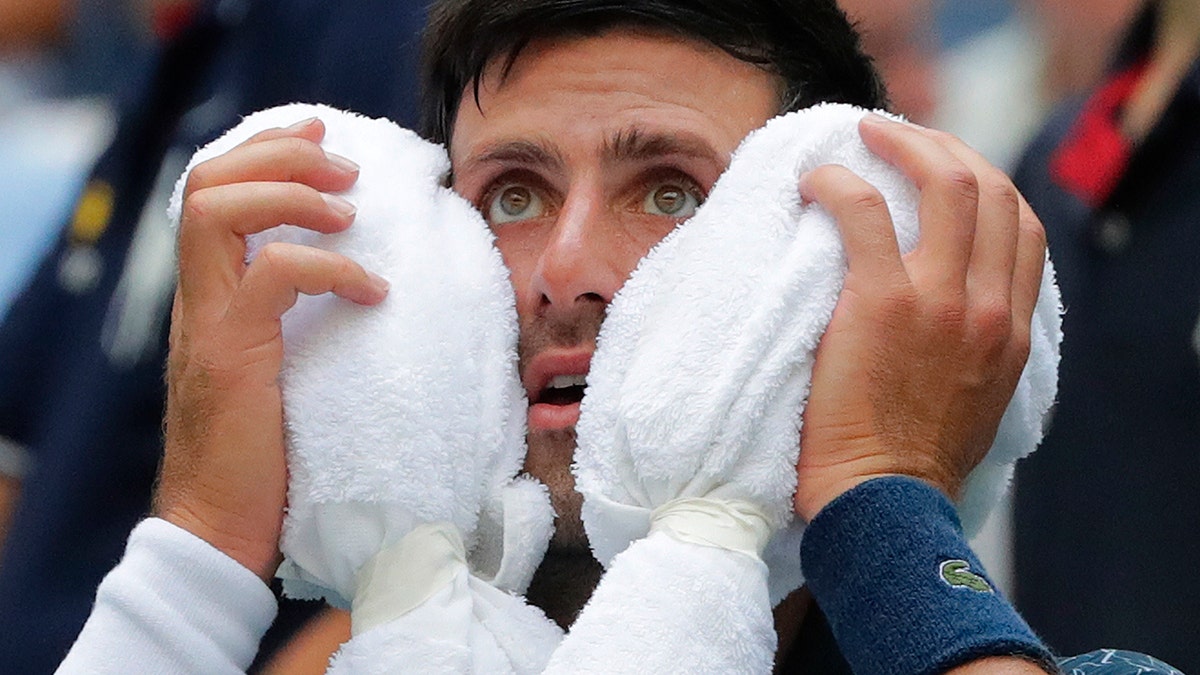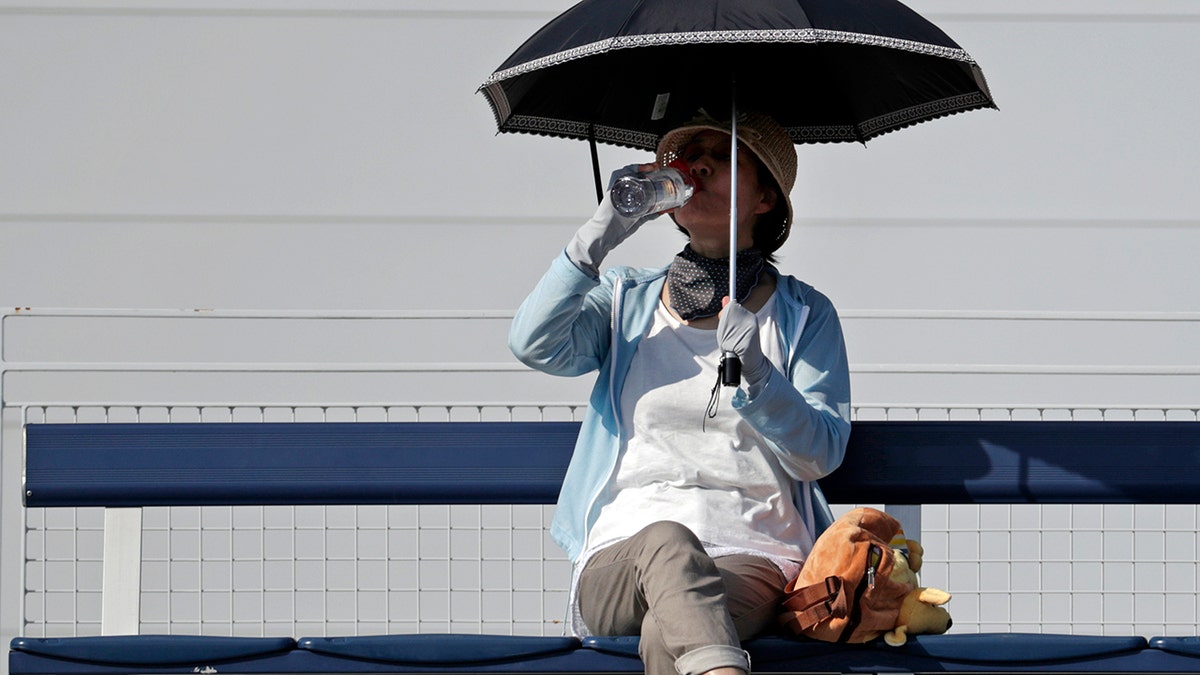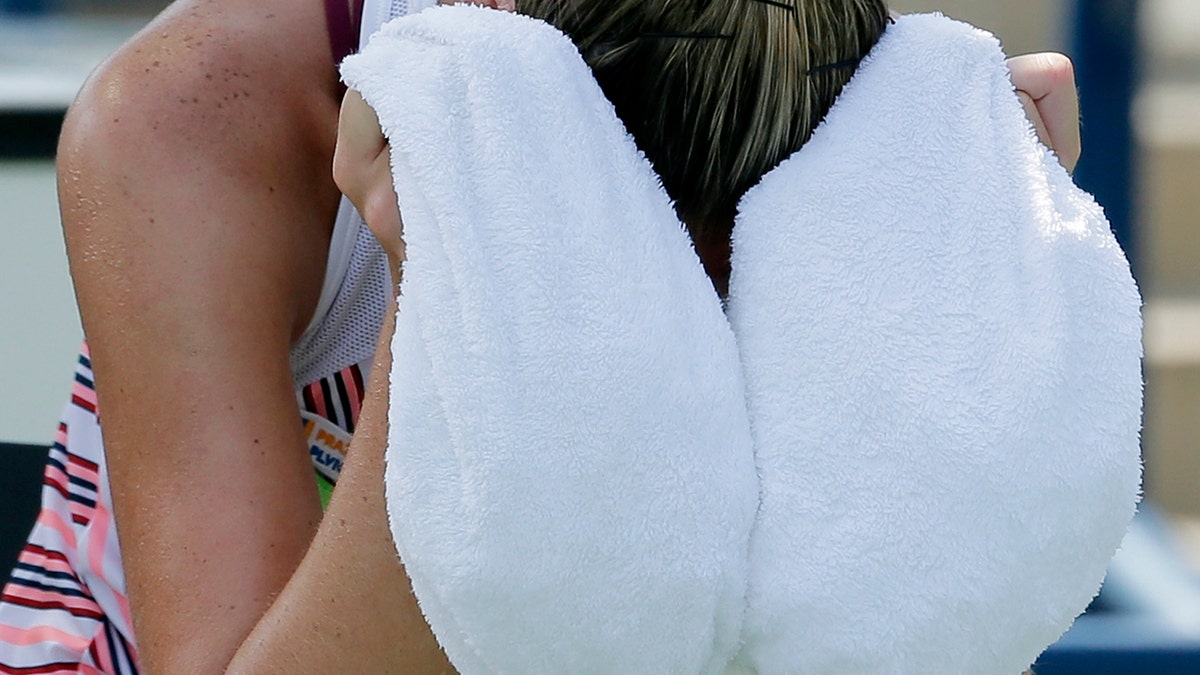
Novak Djokovic, of Serbia, puts an ice towel to his face during a changeover in his match against Marton Fucsovics, of Hungary, during the first round of the U.S. Open tennis tournament. (AP)
Extreme temperatures at the U.S. Open on Tuesday and a scorching weather forecast for Wednesday have officials debating whether to close the roofs at two of the tournament's venues.
The temperatures during Day 2 of the season’s final major topped 95 degrees and the humidity nearly reached 50 percent, making it feel like more than 105 degrees on the courts of the Bille Jean King National Tennis Center in Flushing, N.Y.
Six players were forced to quit their matches Tuesday, with five citing cramps or heat exhaustion.

A fan shelters under an umbrella and sips a drink as she watches the match between Fabio Fognini, of Italy, and Michael Mmoh during the first round of the U.S. Open tennis tournament (AP)
The heat had U.S. Tennis Association executives considering whether to close the roofs at Arthur Ashe and Louis Armstrong stadiums, the Los Angeles Times reported. However, the newly renovated new Louis Armstrong Stadium is a naturally ventilated arena and it was unclear how much relief its new retractable roof could provide, especially with temperatures set to reach the upper 90s once again.
“We may close the roof in both buildings in an attempt to bring down the ambient temperature,” U.S. Tennis Association spokesman Chris Widmaier told the L.A. Times.
The brutal weather even forced tennis officials to do something that had never been done fore at the U.S. Open: offer men the chance to take a 10-minute break before the fourth set if a match went that far. A similar rule is already in place for women, allowing 10 minutes of rest before a third set when there’s excessive heat.

Kristyna Pliskova, of the Czech Republic, cools off with an ice towel during a changeover in her match against Kiki Bertens, of the Netherlands, during the first round of the U.S. Open tennis tournament (AP)
“At the end of the day, the ATP or a lot of the supervisors, they’re kind of sitting in their offices, where (there’s) an A.C. system on, where it’s cool. And we have to be out there. They tell us it’s fine; they’re not the ones playing,” Alexander Zverev, the No. 4 seed in the tournament, said. “For sure, the rule should be more strict. There should be a certain temperature, certain conditions where we shouldn’t be playing.”
Novak Djokovic, one of the favorites to win the men's title, felt the humidity as well.
“Everything is boiling — in your body, the brain, everything,” he said.
On the women’s side, Alize Cornet changed her shirt mid-match and received a warning. Male tennis players are allowed to change shirts on the court.
Petra Kvitova told reporters after her match she was glad it lasted only a little over an hour.
“I really tried hard not to play the third one in this kind of heat,” she said. “I knew it's going to be very hot, but I couldn't imagine how horrible the heat was in, so it was pretty difficult conditions. … When you are playing, you are not just really thinking about it. But when you stop for a while, then you feel the heat like from the ground, as well. Yeah, it was the humidity, as well, was there. We didn't really play, like, long rallies. I think that was kind of helpful.”
Arthur Ashe Stadium opened in 1997 as an open-air stadium. But after several years of rain at the tournament, its roof was installed for around $150 million.
Louis Armstrong Stadium opened in 1978 and has undergone several renovations. Its roof, newly installed, cost $200 million and the stadium is not air-conditioned.
U.S. Open rules state that the tournament is to remain an outdoor event and the roofs will close only due to threat of rain, according to tournament director David Brewer.
The Associated Press contributed to this report.